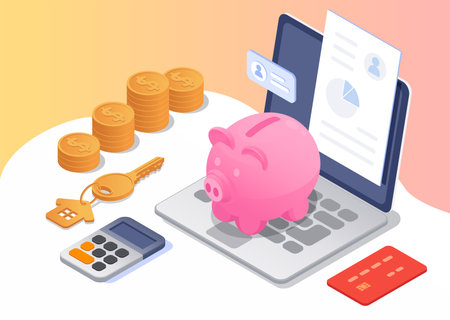1. Understanding Junior ISAs: An Overview
If you’re just starting to look into saving for your child’s future in the UK, you’ve probably heard a lot about Junior ISAs. But what exactly are they, and why is everyone suddenly talking about them? Simply put, a Junior ISA (Individual Savings Account) is a tax-free savings account specifically designed for children under 18 living in the UK. Parents, grandparents, or even family friends can pay money into it, but the money legally belongs to your child—and they’ll get full control over it when they turn 18. Sounds pretty straightforward, right? The real appeal of Junior ISAs is that any interest or investment growth earned on the money inside isn’t taxed at all, making them an incredibly efficient way to help your child build up a nice little nest egg. With university fees and first homes getting pricier by the year, it’s no wonder more parents across Britain are turning to Junior ISAs as their go-to savings option. Whether you’re looking at cash ISAs for simple saving or stocks and shares ISAs for long-term investment potential, understanding how these accounts work could be one of the best financial decisions you make for your child’s future.
2. Tax-Free Growth: How Junior ISAs Shield Your Child’s Savings
If you’re new to Junior ISAs, one of the most appealing perks is the tax-free status. But what does “tax-free” really mean for your child’s savings in the UK? In simple terms, any interest, dividends, or capital gains earned within a Junior ISA aren’t taxed—neither by HMRC nor by local authorities. This means every penny your child’s money earns stays in their account, helping their savings grow even faster over time.
What Does ‘Tax-Free’ Mean?
In everyday banking, interest and investment growth are usually subject to tax once they reach a certain threshold. However, with a Junior ISA, the rules are different:
| Type of Account | Interest/Dividends Taxed? | Capital Gains Taxed? |
|---|---|---|
| Junior Cash ISA | No | No |
| Junior Stocks & Shares ISA | No | No |
This means that whether your child’s savings are earning interest in a cash account or making gains through investments, all those returns are protected from taxes until your child turns 18 (when the account automatically becomes an adult ISA).
How It Applies for Children in the UK
The benefits aren’t just for high earners—every child with a Junior ISA gets this tax-free advantage. Unlike some other accounts where parents might have to fill out forms or worry about tax implications if they contribute large amounts, Junior ISAs make it straightforward. No need to declare earnings on your child’s annual tax return, and no surprise letters from HMRC.
A Simple Example
Let’s say you save £5,000 in a Junior Stocks & Shares ISA, and over the years it grows to £6,000. That extra £1,000 is yours (well, your child’s!) to keep—no tax taken off at all. For many families across the UK, this makes a real difference when planning for things like university fees or that all-important first car.

3. Annual Allowances: How Much Can You Save Each Year
If you’re curious about how much you can tuck away in your child’s Junior ISA each year, you’re not alone! The UK government sets an annual allowance for Junior ISAs, and making the most of this limit is key to maximising your child’s savings potential.
What Is the Junior ISA Allowance?
For the current tax year (2024/25), the annual allowance for a Junior ISA is £9,000. This means you can contribute up to £9,000 across all of your child’s Junior ISAs—whether that’s a Cash Junior ISA, a Stocks & Shares Junior ISA, or a combination of both. It’s important to note that this limit applies per child, not per account.
How Does It Work?
The allowance runs alongside the UK tax year, which starts on 6th April and ends on 5th April the following year. If you don’t use the full allowance within this period, unfortunately, it doesn’t roll over—you simply lose that unused portion for good.
Tips for Making the Most of Each Tax Year
Here are a few simple tips to help you maximise your contributions:
- Plan ahead: Try setting up regular monthly payments so you gradually reach the full allowance without feeling the pinch all at once.
- Don’t leave it too late: Many parents rush to top up accounts just before the tax year ends. By spreading out contributions, you’ll reduce stress and make saving more manageable.
- Gift from family: Grandparents and other relatives can also pay into your child’s Junior ISA, as long as the total annual contributions don’t exceed £9,000.
If you’re able to reach the annual limit every year, your child could have a tidy sum waiting for them when they turn 18—completely tax-free!
4. Cash or Stocks & Shares: Choosing the Right Junior ISA
If you’re thinking about opening a Junior ISA for your child, you’ll quickly discover there are two main types to choose from: Cash Junior ISAs and Stocks & Shares Junior ISAs. Each has its own perks and risks, and what’s right for you will really depend on your financial goals and how comfortable you are with risk. Let’s break it down in a simple way so you can make the best decision for your child’s future savings.
Cash Junior ISAs
Cash Junior ISAs work pretty much like a regular savings account, but with the added bonus of being tax-free. Your child won’t have to pay tax on any interest earned, which is always a win. These accounts are ideal if you prefer to play it safe—your money isn’t exposed to the ups and downs of the stock market, so there’s little chance of losing what you put in. However, do keep an eye on inflation, as it might nibble away at your savings’ real value over time.
Stocks & Shares Junior ISAs
Stocks & Shares Junior ISAs take things up a notch by letting you invest in things like shares, bonds, or funds. These can potentially offer higher returns than cash accounts, but they come with more risk—the value of investments can go up or down depending on how the markets perform. If you’re starting early (say, when your child is very young), there’s more time to ride out any bumps in the market, which could mean better growth in the long run.
Comparing the Two: What Suits Your Needs?
| Feature | Cash Junior ISA | Stocks & Shares Junior ISA |
|---|---|---|
| Risk Level | Low | Medium/High |
| Potential Returns | Lower (but guaranteed) | Higher (but not guaranteed) |
| Suits Budgets | Small/Regular contributions | Larger lump sums or long-term plans |
| Best For | Cautious savers, short-term goals | Long-term growth, comfortable with risk |
| Tax Benefits | No tax on interest earned | No tax on capital gains or dividends within the ISA |
Mixing Things Up: You Can Have Both!
You don’t actually have to pick just one type of Junior ISA—you can split your annual allowance between both if you fancy a bit of balance. For example, some parents start off with a Cash Junior ISA while their children are younger and then move some or all of the savings into Stocks & Shares as they get closer to 18. It all depends on your attitude towards risk and your savings goals.
A Quick Word on Allowances and Flexibility
The total amount you can contribute across both types each tax year is capped (currently £9,000 for 2023/24). So whether you put it all in cash, all in stocks & shares, or a mix of both—it’s that combined limit that counts. Make sure to review your choices regularly, especially if your circumstances change or if you want to adjust your approach as your child gets older.
5. Accessing the Money: What Happens at Age 18
If you’ve been tucking away money in a Junior ISA for your child, you might be wondering what actually happens when they hit the big 1-8. Well, turning eighteen is a major milestone in the UK—not just for voting or heading to the pub, but also because that’s when your child finally gains full control over their Junior ISA savings.
The Transition from Junior ISA to Adult ISA
On their 18th birthday, your child’s Junior ISA automatically turns into an adult cash or stocks and shares ISA. This means the money is no longer ‘locked up’ by parental rules—your child can decide exactly what to do with it, whether that’s continuing to save or making a withdrawal for something important.
Freedom to Spend or Save
Your now-adult child can use their savings however they like. For many young people, this pot of money is a real game-changer. Some might use it towards uni expenses—think tuition fees, course materials, or even accommodation deposits. Others could opt to buy their first car, which is a classic rite of passage here in the UK. And let’s not forget those who dream of seeing the world; a gap year adventure across Europe or further afield suddenly becomes much more achievable.
Planning Ahead for Their Future
It’s worth having an open chat with your teen as they approach this birthday. While it’s tempting to blow the lot on fun stuff, encouraging them to balance spending with saving could help set good habits for life. After all, with the ongoing tax-free benefits if they leave funds in the adult ISA, there’s still plenty of incentive to keep building their nest egg for future milestones—like a house deposit or starting a business.
In short, reaching 18 opens up a world of possibilities—and it’s all thanks to those early savings and clever tax benefits offered by Junior ISAs. Whether it goes on education, travel, or something else entirely, your child has a solid financial springboard to start their adult journey in style.
6. Tips for Parents: Maximising Your Child’s Future Savings
When it comes to making the most out of a Junior ISA, every little helps! Here are some simple and practical tips for parents who want to give their children a solid financial head start in the UK.
Make Regular Contributions
It might sound obvious, but consistency is key. Setting up a monthly standing order—even if it’s just £10 or £20—can add up impressively over time thanks to the power of compounding interest. Plus, regular contributions take away the stress of remembering to top up the account.
Encourage Family Gifts
Instead of toys that gather dust, why not ask grandparents, aunties or uncles to contribute to your child’s Junior ISA on birthdays or Christmas? It’s a thoughtful way for family members to invest in your child’s future, and every gift goes towards their long-term goals.
Use Your Allowance Wisely
The annual Junior ISA allowance resets every tax year, so try to use as much of it as you can. Even if you can’t reach the maximum each year, whatever you do manage to save will still grow tax-free. Keep an eye on changes to the allowance at each new tax year—sometimes the government increases it!
Review Investments Regularly
If you’ve chosen a stocks & shares Junior ISA, remember to check in on how things are going every so often. While you don’t need to be glued to the market, a quick review once or twice a year can help ensure your child’s savings are growing as expected.
Start Early
The earlier you open and begin contributing to a Junior ISA, the more time those savings have to grow. Even small amounts invested when your child is very young can make a big difference by the time they turn 18.
Get Your Child Involved
As your child gets older, involve them in tracking their Junior ISA savings. Not only does this teach them about money management, but it also helps them appreciate the benefits of long-term saving—and maybe even motivates them to save a bit of their pocket money too!
By following these straightforward strategies, parents across the UK can really maximise what Junior ISAs have to offer—making sure their kids have a great pot of savings waiting for them when they reach adulthood.


